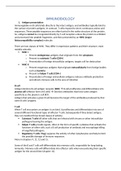IMMUNOBIOLOGY
1. Antigen presentation
Immunoglobin on B cells binds directly to the intact antigen, and antibodies typically bind to
the surface of protein antigens. In contrast, T cells respond to short, continuous amino acid
sequences. These peptide sequences are often buried in the native structure of the protein.
So, antigens cannot be recognized directly by T-cell receptors unless the protein is unfolded
and processed into peptide fragments, and then presented by an MHC (major
histocompatibility complex) molecule.
There are two classes of MHC. They differ in expression patterns and their structure, most
notably subunits.
MHC I
o Present endogenous antigens that originate from the cytoplasm
o Present to cytotoxic T cells (CD8+)
o Presentation of foreign intracellular antigens; targets cell for destruction
MHC II
o Present exogenous antigens that originate extracellularly from foreign bodies
such as bacteria
o Present to helper T cells (CD4+)
o Presentation of foreign extracellular antigens; induces antibody production
and attracts immune cells to the area of infection
B cell
Antigen binds to B-cell antigen receptor (BCR) B-cell proliferates and differentiates into
plasma cell (effector form of B cells) Secretes antibodies that have same antigen
specificity as the plasma’s cell BCR.
Antigen that activates a given B cell becomes the target of the antibodies produced by that
same B cells’ progeny.
T cell
When T cell encounters an antigen it can bind, it proliferates and differentiates into one of
several different functional types of effector T cells. Subsequently if they detect antigen,
they can manifest three broad classes of activity;
Cytotoxic T cells kill other cells that are infected with viruses or other intracellular
pathogens bearing the antigen.
Helper T cells provide signals, often in the form of specific cytokines that activate the
functions of other cells, such a B cell production of antibody and macrophage killing
of engulfed pathogens.
Regulatory T cells (Treg) suppress the activity of other lymphocytes and help to limit
the possible damage of immune responses.
More in chapters 9, 11, 12 and 15.
Some of the B and T cells will differentiate into memory cells, responsible for long-lasting
immunity. Memory cells will differentiate into effector cells when encountering their specific
antigen for the second time (chapter 11).
,Dendritic cells have pattern recognition receptors, which when activated trigger the
dendritic cell to express cell-surface proteins called co-stimulatory molecules, which
support the ability of the T cell to proliferate and differentiate. Therefore, dendritic cells are
also referred to as antigen presenting cells (APCs). They form a crucial link between the
innate immune response and the adaptive immune response;
Innate immune response; prevents the immediate spread of pathogen and/or
foreign substances through the body. Consists of natural killer cells, macrophages,
neutrophils, dendritic cells, mast cells, basophils, and eosinophils.
Adaptive immune response (second line in defense, also called specific immunity);
attacks specific (non-self) pathogens. Hallmark is that B and T cells can clone
themselves, so that at a very rapid pace an army is formed, as all the clones bind to
the same antigen and therefore produce antibodies that attack the same pathogen.
Sometimes this goes wrong and the organism’s healthy cells are attacked autoimmunity
Innate = fast (<96 hours), immediate intervention
Adaptive = relatively slow, specific intervention
T cells express either a CD4 or CD8 protein, which results in CD4+ and CD8+ T cells.
CD4+ cells activate other lymphocytes
CD8+ cells kill other cells
, Step by step plan for immune system
There are three divisions in our immune system to stop pathogens from entering:
1. Barrier immunity
2. Innate immunity
3. Adaptive immunity
- Barrier immunity (1st line of defense)
Basically, this is the skin.
- This is the physical barrier that prevents pathogens from entering easily.
- In addition, the skin has a chemical and biological barrier as well.
o Biological: Immune cells
o Chemical: Antimicrobial proteins
o Shedding of skin epithelium (desquamation)
- Also, the skin facilitates a very small but effective eco system of ‘friendly’ bacteria
that appreciate the environment as is. Therefore, they will work in our favour and
help fend off pathogens which could potentially ruin the harmony.
Also, the respiratory-, GI (gastrointestinal)- and Genito-urinary epithelium and the nose
and pharynx are important physical and chemical (antimicrobial) barriers.
The stomach keeps its environment very acidic which kills most pathogens directly.
Tears in our eyes contain antimicrobial compounds
- Innate immunity (2nd line of defense)
This is called innate because it is present before birth. It is non-specific.
Cells of innate immunity (leukocytes):
- Neutrophils
o Most abundant (60-70%)
o Function: Phagocytosis that kill and eat the pathogens
o Enzymes in their granules (defensins, serine proteases and others)
o Found in blood, highly mobile but short lived
o They can enter sites of tissue where other cells cannot reach
o Usually, they are the first cells to respond to infection
- Mast cells
o Reside in connective tissue and mucous membranes
o Associated with wound healing as well as serious allergies and anaphylaxis
o Numerous granules containing Histamine and Heparin, which dilate blood
vessels and recruit neutrophils and macrophages
o Help to link innate and adaptive immunity
- Basophils
o Least common (0,5-1%)
o Important role in fighting parasitic infections and blood clotting (as granules
contain Heparin)
o Implicated in various allergic reactions
- Dendritic cells






